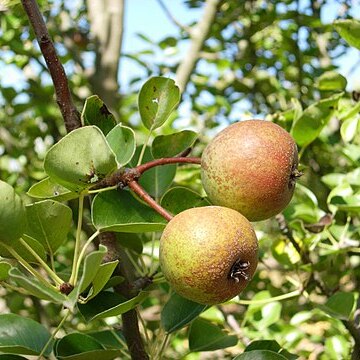Trees to 12 m tall, with branches often armed. Branchlets purplish brown or dark brown when old, terete, lanate when young, glabrous when old; buds ovoid, apex obtuse; scales puberulous along margin. Stipules caducous, linear-lanceolate, 4–8 mm, membranous, adaxially pubescent, margin entire, apex acuminate; petiole 1.5–3 cm, initially pilose, soon glabrescent; leaf blade ovate or narrowly ovate, rarely elliptic, 4–7 × 2–5 cm, tomentose when young, glabrescent, base rounded, rarely broadly cuneate, margin obtusely serrate, apex acuminate or acute. Raceme umbel-like, 7–13-flowered; peduncle initially tomentose, glabrescent; bracts caducous, linear, 8–10 mm, membranous, both surfaces tomentose, margin entire, apex acuminate. Pedicel 2–3 cm, initially tomentose, glabrescent. Flowers 2–5 cm in diam. Hypanthium cupular, abaxially tomentose. Sepals triangular, 3–6 mm, both surfaces tomentose, margin entire, apex acute, acuminate, or obtuse. Petals white, obovate, 8–10 × 4–6 mm, base shortly clawed, apex rounded. Stamens 25–30, slightly shorter than petals. Ovary 3–5-loculed, with 2 ovules per locule; styles 3–5, nearly as long as stamens, glabrous. Pome brown, with pale dots, subglobose, 1–1.5 cm in diam.; sepals caducous; fruiting pedicel 2–3 cm, subglabrous. Fl. Mar–Apr, fr. Aug–Sep. 2n = 34*.
More
A tree. It grows 8-12 m high. It loses its leaves during the year. The leaves have stalks. The leaves are smooth. They are 3-7 cm long by 1.5-3 cm wide. They are oval to sword shaped. They taper to the tip. They have shallow rounded teeth along the edge. They are shiny and are often woolly underneath on young plants. The flowers are white. They have stalks. The fruit is round and covered with white dots.
It is a temperate plant. In Vietnam it grows between 1,000 and 2,000 m altitude. In Nepal it grows between 700-2600 m altitude. It grows in open, rocky places. In Yunnan in China it grows between 1000-1500 m altitude. It grows in secondary forest. It suits hardiness zones 5-9. Arboretum Tasmania. In Sichuan.
More
Shrubberies in the Himalayas; at elevations up to 2,700 metres. Moist sandy, loamy and yellow red clay, near small streams or swamp areas, but also at the lower forest edge near rice paddy fields and open shrub land in Vietnam.
Shrubberies in the Himalayas; at elevations up to 2,700 metres. Valleys, amongst shrubs; at elevations from 600-3,000 metres.


